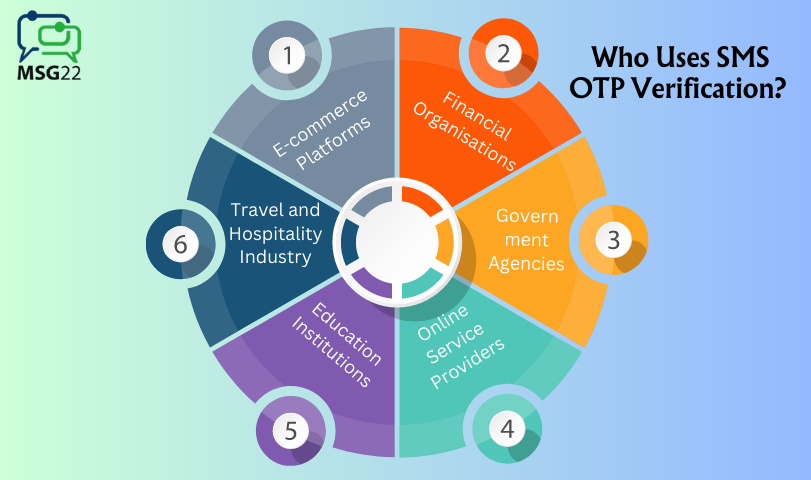In today’s digital age, security is paramount, especially when it comes to verifying the identity of your customers. SMS OTP (One-Time Password) Verification is a powerful tool that ensures the safety of your customers’ accounts and sensitive information.
By implementing OTP SMS Verification, you can protect both your customers and your business from unauthorized access, fraudulent activities, and data breaches. This reliable and user-friendly method adds an extra layer of security by sending a unique verification code to the customer’s mobile phone, which they must enter to confirm their identity. With SMS OTP Verification, you can instill trust, enhance security, and provide a seamless and secure experience for your customers, enabling them to transact with confidence while safeguarding your business from potential threats.
What is SMS OTP Verification?
A one-time password, also known as an OTP, is a temporary authentication code that is delivered by SMS to a user’s registered cellphone number. The system will automatically create and deliver an OTP SMS whenever a user registers into an app or conducts an online transaction. Users won’t be permitted to log in or conduct transactions unless they input the proper OTP within the allotted time period. This stops fraudulent transactions or unauthorised use before they happen.
Who Uses SMS OTP Verification?

Numerous companies and sectors utilize SMS OTP verification often. Here are a few instances of those that make use of SMS OTP verification:
E-commerce Platforms: To safeguard client accounts, confirm transactions, and stop unauthorized access, e-commerce platforms, and online merchants use SMS OTP verification.
Financial organisations: To increase security during login, cash transfers, and other sensitive transactions, banks, credit card companies, and other financial organisations rely on SMS OTP verification.
Government Agencies: To secure citizen portals, provide secure access to government services, and safeguard sensitive citizen data, government organizations use SMS OTP verification.
Online service providers: Online service providers utilise SMS OTP verification to confirm user accounts and guard against fraudulent actions. Examples of these providers include software-as-a-service (SaaS) platforms, web hosting firms, and subscription-based services.
Education Institutions: To secure student portals, validate user accounts, and safeguard student information, educational institutions use SMS OTP verification.
Travel and Hospitality Industry: Airlines, hotels, and travel agencies use SMS OTP verification to secure reservations, confirm client identities, and guard against fraud in the travel and hospitality sector.
Why is SMS the Best Medium for OTP Verification?
Due to a number of significant benefits it provides, SMS is regarded as the finest medium for OTP verification.
- Security: By delivering a one-time password specifically for SMS OTP verification to the user’s mobile phone, an additional degree of protection is created. By using this technique, the danger of unauthorized access is reduced since the verification code is given to a device that is normally in the custody of the authorized user.
- High Delivery Rates: When compared to other communication channels, SMS claims high delivery rates. Sending OTPs through SMS is dependable and effective since the recipient’s mobile device receives the message directly. With SMS, you can be sure that the user will receive the verification code right away.
- Low Latency: SMS OTP has extremely little latency, therefore messages are delivered nearly instantly. This timely delivery makes sure that users get their OTPs on time, enabling a smooth and effective verification procedure.
- High Read Rates: According to research, SMS messages often get read within minutes of being sent. Due to the high read rate, users are more likely to quickly view and enter the OTP, lowering the risk of expiration and ensuring a seamless verification process.
How does SMS OTP verification work?
The method for SMS OTP verification is simple and includes the following steps:
User Request: Users are requested to provide their phone number for verification when they start a transaction or want to access a secure part of a website or application.
OTP Generation: The system creates a special one-time password (OTP) after obtaining the user’s phone number. This OTP is an alphanumeric code that was produced at random and is only good for a short time, usually a few.
OTP Delivery: An SMS is used to deliver the generated OTP to the user’s mobile device. The OTP is included in the SMS, along with maybe some code-entry instructions.
User verification: The user’s mobile device receives an SMS with the OTP. To finish the verification procedure, they input the OTP into the appropriate space on the website or application.
OTP Validation: The system then verifies the entered OTP. The user is validated and given access to the requested service or transaction if the inputted code matches the one created and provided through SMS.
Time Limit: To protect its security, the OTP has a predetermined expiration date. The user might have to ask for a fresh OTP for verification if they don’t input the OTP within the allotted period.
How to set up an automated SMS OTP process?
You may use MSG22, a well-known OTP SMS service provider that provides powerful features for delivering SMS OTP messages, to set up an automated SMS OTP procedure. Here is a step-by-step tutorial for configuring MSG22 to automate SMS OTP
Register and set up an account: Create an account by going to MSG22.com and entering your information. Complete the registration procedure by providing the needed data.
After creating an account, visit your MSG22 account dashboard to obtain API credentials. Create your API credentials by going to the API area. The MSG22 services will be integrated with your program or website using these credentials.
API integration: Depending on the context in which your application or website is being developed, you may integrate the MSG22 API by following the instructions that they have supplied. Utilizing the supplied API credentials, the integration procedure normally entails sending HTTP queries to MSG22’s API endpoints.
Generate an OTP: Include logic to create a distinct OTP for each user request in your application or website. The use of a random alphanumeric code generator can accomplish this.
Send OTP: Once the OTP has been produced, send an HTTP request to the MSG22 API endpoint, including your API credentials, the recipient’s phone number, and the text of the OTP message. The SMS transmission procedure will start as a result.
Verify OTP: Incorporate the appropriate logic into your application or website to compare the produced OTP to the OTP entered by the user. Verify the inputted OTP matches the one that is already saved in your system by comparing them.
Test and Deploy: To guarantee a seamless user experience and appropriate handling of OTP verification, thoroughly test the integration and operation of your automated SMS OTP process before deploying it in a live environment.
You may create an automated SMS OTP method to improve security and confirm user IDs within your application or website by using these steps and integrating MSG22’s SMS services.
Conclusion
Implementing SMS OTP (One-Time Password) verification is a crucial step in ensuring the safety and security of both your customers and your business. By utilizing SMS OTP verification, you add an extra layer of protection to sensitive transactions, login processes, and account activities. This not only reduces the risk of unauthorized access and fraudulent activities but also enhances customer trust and confidence in your brand.
SMS OTP verification acts as a reliable and convenient method to verify the identity of users, mitigating the risks associated with data breaches and identity theft. By prioritizing the security of your customer’s information and transactions, you demonstrate your commitment to their privacy and well-being. Don’t compromise on security—implement SMS OTP verification today and safeguard your customers and your business against potential threats.
Frequently Asked Questions
How safe is SMS OTP?
One-Time Passwords sent over SMS are typically regarded as safe authentication methods. It adds an extra degree of protection by asking users to input a special code that is provided to their mobile phones through SMS.
Can SMS OTP Verification be integrated into different platforms?
Yes, a variety of systems may incorporate SMS OTP Verification. To enable developers to incorporate SMS OTP functionality into their websites, mobile applications, or other systems, several service providers provide APIs (Application Programming Interfaces).
Is SMS OTP Verification user-friendly?
Due to its familiarity and widespread use, SMS OTP Verification is typically seen as being user-friendly.
Can SMS OTP Verification be used for multiple purposes?
Yes, there are many uses for SMS OTP Verification. It is frequently used for transaction verifications, password resets, and user authentication during account signup.








